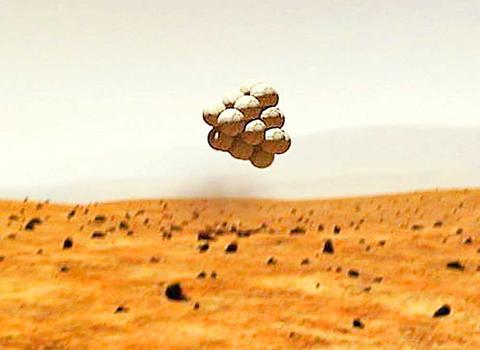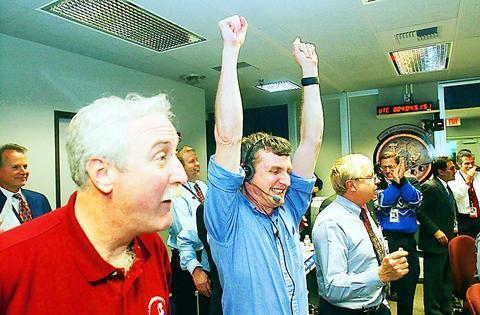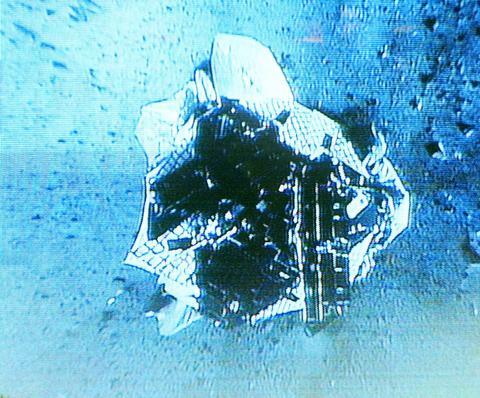The robot spacecraft rover named Spirit landed safely on Mars yesterday, Taiwan time, after a perfectly programmed descent by parachute and a final programmed adjustment of its position to place it precisely on its target near the center of a Martian crater that may once have been a brimming lake billions of years ago.
It was America's fourth successful landing on the Red Planet and marked the beginning of a new mission to learn whether Mars was once a habitable place where water flowed abundantly in lakes, rivers, creeks and canyons -- and life, perhaps, may once have flourished.

PHOTO: AP
As applause and cheers erupted and tension eased among Mission Controllers here at NASA's Jet Propulsion Laboratory, scientists began sending computer commands across 160 million kilometers of space to prepare the spacecraft for its travels across the Martian terrain and its search for evidence of ancient sediments in Martian rocks that will start within the next nine days.

PHOTO: AP
Spirit, the size of a golf cart and weighing a ton, landed in the Gusev crater on Mars almost precisely at its programmed time of 8:35pm, California time, bouncing again and again for more than 10 minutes inside its protective cluster of Kevlar until it finally rolled to a stop hundreds of yards from where it first hit the Martian surface.
The computers at Mission Control timed the landing at precisely 8:35pm, Ed Theisinger, the project director, said. "Within a second or two at most," said Rob Manning, the engineer who directed the spacecraft's entry into the Martian atmosphere, its descent by parachute and retro-rocket, and its final landing.

PHOTO: AFP
And the position of the landing was precisely as it was designed, said the engineers -- with the base of the spacecraft safely down rather than canted -- a sign that before many days Spirit will be ready to roll off the three petal-shaped runways that had enfolded the spacecraft all the way from Earth and begin to work.

PHOTO: AFP
Engineers and scientists had been biting their nails throughout the day, but the spacecraft's course was set on Friday without chance of change by Spirit's mission controllers here at the Jet Propulsion Laboratory.
The giant antennae of NASA's Deep Space Network in Australia and California's Owens Valley picked up the faintest signals from Spirit's final arrival, and Mission Control strained to decipher faint humming tones from the lander itself, but minute after minute passed before the engineers were satisfied that the landing had indeed been successful.

PHOTO: AFP
Aside from the incredible technical challenges posed by this unprecedented effort to land a vehicle the size of a golf cart on a precise spot in the precise center of a giant Martian crater, mission controllers had warned of fresh dangers as the landing moment neared.
A sandstorm on the surface many kilometers away was changing the density of the atmosphere over the landing site, according to Rob Manning, who runs the team overseeing the entry and parachute landing of the Spirit. Winds up to 32kph may have been blowing at the site as the landing moment approached, Manning said.
That would make things tougher than ever, although a camera on the base of the spacecraft can detect any dangerous swaying of its parachute above, and tiny rockets are programmed to detect the swaying and correct Spirit's downward course only seconds from the surface.
After a curving journey of 480 million kilometers to a planet 170.2 million kilometers from Earth, one might think the hardest part of the trip was over. But now the airbags must be removed, the rover must raise its mast and train its stereoscopic cameras around its environment to hunt for promising rocks, and Spirit's solar-powered batteries must operate flawlessly.
As landing time neared, Louis D'Amario, chief space navigator for the mission, said: "It's been like teeing off in Paris for a golf game and hitting a hole in Tokyo with a breeze and a little water hole the size of an ocean in between.
"But as Spirit's course looks right now, it's been perfect navigation."
The spacecraft's landing site, Gusev, is a giant crater just north of the Martian equator. Images from space show it may have been a huge lakebed billions of years ago, filled with water from streams flowing in torrents down from the southern highlands of Mars.
Spirit had been scheduled to wait nine days or so after its scheduled landing while its high-resolution stereo camera surveys nearby rocks to pick out the most likely ones that show signs of holding sediments from Gusev's possibly ancient flowing water.
The craft's spectrometers are designed to detect evidence of ancient sediments from within the lake and its grinding tool will scrape away the surfaces of sedimentary rocks.
In another 21 days, Spirit's counterpart, the spacecraft named Opportunity, will land on a site called Meridiani Planum, halfway on the other side of the planet from the Gusev crater. And if water were ever there, it could have created rocks called grey hematite, an iron oxide frequently formed within iron-rich water. The rover's instruments are specially equipped to identify that glittering silvery rock.
Said Ed Weiler, NASA's director of space science: "This mission is not about rocks, it's not about pictures; it's part of our first steps in answering a great human question: Are we alone?"
Two Viking spacecraft landed there in 1976 seeking organic chemicals and possible micro-organisms beneath the surface but found only exotic chemistry.
The mission called Pathfinder carried a tiny rover called Sojourner that analyzed a variety of Martian rocks in 1997 and found no conclusive evidence of ancient water. Another effort to land on a Martian polar ice cap in search of liquid water crashed four years ago.
Updated NASA information on the Mars Rover Exploration is on the Web at http://marsrover.jpl.nasa.gov/home/index/html.

Last week saw the appearance of another odious screed full of lies from the People’s Republic of China (PRC) Ambassador to Australia, Xiao Qian (肖千), in the Financial Review, a major Australian paper. Xiao’s piece was presented without challenge or caveat. His “Seven truths on why Taiwan always will be China’s” presented a “greatest hits” of the litany of PRC falsehoods. This includes: Taiwan’s indigenous peoples were descended from the people of China 30,000 years ago; a “Chinese” imperial government administrated Taiwan in the 14th century; Koxinga, also known as Cheng Cheng-kung (鄭成功), “recovered” Taiwan for China; the Qing owned

In Taiwan’s politics the party chair is an extremely influential position. Typically this person is the presumed presidential candidate or serving president. In the last presidential election, two of the three candidates were also leaders of their party. Only one party chair race had been planned for this year, but with the Jan. 1 resignation by the currently indicted Ko Wen-je (柯文哲) of the Taiwan People’s Party (TPP) two parties are now in play. If a challenger to acting Chairman Huang Kuo-chang (黃國昌) appears we will examine that race in more depth. Currently their election is set for Feb. 15. EXTREMELY

Jan. 20 to Jan. 26 Taipei was in a jubilant, patriotic mood on the morning of Jan. 25, 1954. Flags hung outside shops and residences, people chanted anti-communist slogans and rousing music blared from loudspeakers. The occasion was the arrival of about 14,000 Chinese prisoners from the Korean War, who had elected to head to Taiwan instead of being repatriated to China. The majority landed in Keelung over three days and were paraded through the capital to great fanfare. Air Force planes dropped colorful flyers, one of which read, “You’re back, you’re finally back. You finally overcame the evil communist bandits and

They increasingly own everything from access to space to how we get news on Earth and now outgoing President Joe Biden warns America’s new breed of Donald Trump-allied oligarchs could gobble up US democracy itself. Biden used his farewell speech to the nation to deliver a shockingly dark message: that a nation which has always revered its entrepreneurs may now be at their mercy. “An oligarchy is taking shape in America of extreme wealth, power and influence that literally threatens our entire democracy, our basic rights and freedoms,” Biden said. He named no names, but his targets were clear: men like Elon Musk